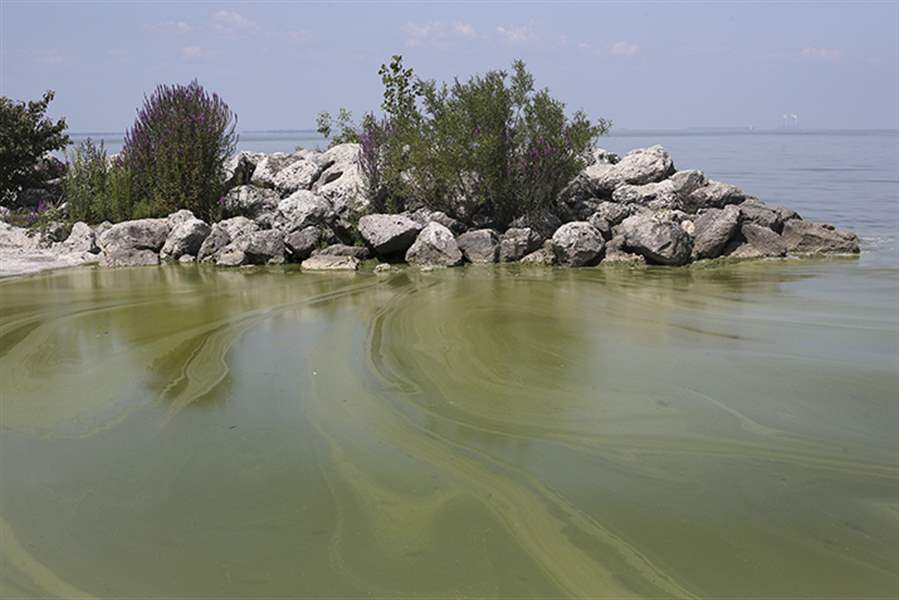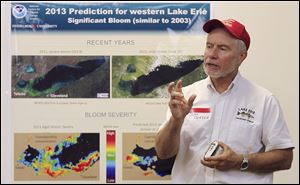
Study: Earth’s fresh-water resources at risk
Climate change makes conditions ripe for algal blooms across the globe
1/11/2015
Algae floats in Lake Erie in August at Maumee Bay State Park in Oregon. The algae, cyanobacteria, is harder to get rid of than previously thought, a new study suggests.
THE BLADE
Buy This Image

Algae floats in Lake Erie in August at Maumee Bay State Park in Oregon. The algae, cyanobacteria, is harder to get rid of than previously thought, a new study suggests.
Although western Lake Erie has become an international poster child for noxious algae, a new study suggests that many of the world’s much smaller, cleaner, and calmer bodies of water are likewise in trouble if greater efforts are not undertaken to keep farm fertilizers and other nutrients out of them.
The study’s lead author, Dartmouth College biology professor Kathryn Cottingham, said that’s more evidence of how climate change, population growth, and poor land-use practices are putting the Earth’s dwindling freshwater resources at risk.
The newly published report, which appears in the scientific journal Ecosphere, is funded by the federal government’s National Science Foundation. It is a collaboration among researchers at Dartmouth, Bates College in Maine, Virginia Polytechnic Institute and State University, and the private, nonprofit Cary Institute of Ecosystem Studies in Millbrook, N.Y.
It combined field work in northern New England with scientific data generated by smaller, cleaner, and calmer bodies of water — mostly inland lakes — from other parts of the world.
The authors concluded that once cyanobacteria — the fancy word for harmful blue-green algae — creeps into those still bodies of water, it is harder to get it out than previously thought.
Nitrogen and phosphorus in the algae itself gets recycled and combines with fresh runoff to form more algae, resulting in a near-perpetual cycle of goopy green stuff that is difficult to break in certain bodies of water.
“In relatively clear-water systems, some of the nutrients are recycled,” Ms. Cottingham said. “It starts a runaway train. These are warnings that things are going south and we need to be more definitive about land-use management.”

CTY algae03p 07/02/2013 The Blade/Lori King Dr. Jeff Reutter, director of the Ohio Sea Grant and Stone Laboratory, talks about harmful algal blooms in Lake Erie during a media briefing at Stone Laboratory on Put-in-Bay.
Conventional thinking has been that less runoff means less algae.
That’s still true in general. But according to this new study, the global problem with climate change has made conditions ripe for more algal blooms from one summer to the next, even in bodies of water known to be quiet and clear.
Such blooms “are reported to be increasing in many areas due in part to global climate change,” the report states.
That, it said, means blooms one summer should “warrant attention as potential drivers” of blooms in future years because of how they recycle nutrients.
Results from the combined field work and data on blooms from other parts of the world are “sufficiently compelling” to warrant more research on how blooms are regenerated in part by themselves, the paper said.
“It’s a thorny problem,” Ms. Cottingham said. “It underscores the need to be more proactive.”
The research also suggests algae acts differently in different bodies of water, including western Lake Erie.
Jeff Reutter, Ohio Sea Grant and Ohio State University Stone Laboratory director, has stated on numerous occasions he believes western Lake Erie’s algae problem is fixable.
So has Rick Stumpf, a National Oceanic and Atmospheric oceanographer and the lead researcher for a new algae-forecasting system that began in 2012. It was developed by Mr. Stumpf and other scientists at NOAA’s National Centers for Coastal Ocean Science in Silver Spring, Md.

Scientists such as Rick Stumpf, NOAA oceanographer and lead researcher of that agency’s algae forecast, gathered last year at OSU’s Stone Laboratory near Put-In-Bay to discuss the algae forecast for western Lake Erie.
Both have urged the state of Ohio to seek at least a 40 percent reduction in runoff of commercially sold farm fertilizers and animal manure. Agricultural runoff of various forms is widely cited as the biggest source of phosphorus, nitrogen, and other nutrients that help algae grow, with untreated sewage spills the next biggest problem.
Similar calls have been made by a special Ohio phosphorus task force and the U.S.-Canada International Joint Commission, which helps the two countries research and resolve common boundary water issues.
Ms. Cottingham said she has been collaborating more with Lake Erie scientists since last August’s algae-induced water crisis in Toledo, which made tap water unsafe for the metro area’s 500,000 customers for three days.
She agreed that aggressive reductions in runoff could yield immediate benefits.
“Our modeling study suggests lakes with fast-flushing systems, like Lake Erie, are not as vulnerable,” Ms. Cottingham said.
Lake Erie is the world’s 11th largest lake in surface area. But water also passes through it quickly as it flows over Niagara Falls, into Lake Ontario, and out to the Atlantic Ocean via the St. Lawrence River.
In 2012, Lake Erie was nearly algae-free and crystal clear when the region underwent its worst drought in 50 years.
That, according to Mr. Reutter, Mr. Stumpf, and others, underscored the need to reduce runoff — especially in this era of climate change, in which there are many more violent, heavy storms pushing nutrients into the water.
Although there was a drought in 2012, storms dropping 3 or more inches of rain within 24 hours are up significantly in the Midwest since the 1960s.
The bottom line is that better planning and protection is needed to keep all of Earth’s freshwater lakes — even those in good shape now — from becoming fouled by algae, especially with greater demands placed on them by a growing worldwide population.
“That’s certainly the implication,” Ms. Cottingham said.
Contact Tom Henry at: thenry@theblade.com, 419-724-6079, or via Twitter @ecowriterohio.